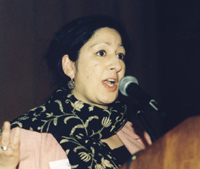|
|
 |
 |
 |
 |
|
AROUND THE QUADSPanel Reflects on Move to CoeducationBy Shira Boss-Bicak ’93
Faculty and administrators who were involved in the decision to make the College coeducational in 1983 spoke about that decision on a panel in March organized by Wendy Lee ’98 and Columbia College Women. Columbia was the last Ivy League school serving exclusively male students, and at the time, most students and faculty agreed that admitting women was a necessary and positive change, according to the panel members, who noted that the College was suffering in admissions compared with schools that had gone coed. A survey at the time showed 84 percent of the incoming class was in favor of admitting women. A strong advocate of coeducation was the late Arnold Collery ’25, who became dean of the College in 1977. “He said, ‘I don’t understand why there are only men here,’” reported former associate dean and current professor of English Michael Rosenthal. Arguments against admitting women were thin, said the panel members, many of whom at the time served on a committee examining the issue. One concern taken seriously was how the College going coed might negatively affect Barnard. Initial discussions indicated that Barnard had no interest in somehow being absorbed by the College. Through what University Professor Fritz Stern described as a loophole in the University’s charter, the College could have gone coed without Barnard’s consent, but “it would have been a hostile act,” Stern said. The committee examined the fates of several colleges in similar situations and found that in none of the cases did going coeducational destroy their all-women neighbors, an example being Notre Dame and St. Mary’s. “Single-sex education for men was dead, but for women there was and is still a rational argument for single-sex undergraduate education,” said former Dean of the Graduate School of Arts & Sciences Gillian Lindt. It was generally agreed that a place existed both for Barnard and a coeducational Columbia College, and that a different pool of female students would apply to each school. “Who would apply [to Columbia] was not the Barnard undergraduates, but the women going to Princeton and other coed institutions,” said University Professor Ronald Breslow, who chaired the committee. The College was opened to female applicants, and they composed 45 percent of the first coeducational class, which was “twice that of other Ivy League schools,” according to Rosenthal. At graduation in 1987, the women “mopped up all of the prizes,” Breslow noted. Between the time of admitting women and their arriving on campus, much work went into adapting the College infrastructure to accommodate women, as health service, housing, facilities, student counseling, security and other programs had to be revamped. Adjustments continued during the first years of coeducation, noted Andrea Solomon ’87, who with John LaRocca ’86 spoke on the panel representing students of that period. Solomon recalled encountering urinals in the wom7en’s rest rooms, which often were marked by a makeshift addition of “WO” before “MEN.”
|
|
||||||||||||||||||||||||||||||||||||||||||||||||||||||||||
